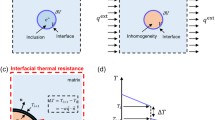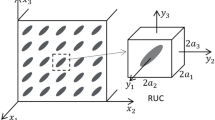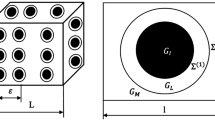Abstract
While several micromechanical models have been developed today in the literature for two-phase media, the extent of their applicability to multiphase materials need yet to be investigated. The present paper studies the effective thermal conductivity of multicomponent composites, and concentrates on two methods: (a) the Mori-Tanaka model, (b) The “generalized self-consistent scheme”. The Mori-Tanaka method of “back-stress” previously developed in the context of elasticity of composites is applied here to the conduction problem. The “generalized self-consistent scheme”, based on a particle-matrix embedding in the effective medium, is studied in this paper in the context of multicomponent media and two variations of this method distinctly different in their imbedding procedure are proposed.
Numerical results are given for three-phase composites illustrating and comparing the proposed methods.
Resumé
Plusieurs modéles de micromécanique existent aujoud'hui dans la litérature des matériaux á deux phases. L'applicabilité de ces modéles aux matériaux á multi-phases nécessite d'autre part d'être examinée. Ce travail étudie la conductivité thermale des matériaux á multi-phases et se concentre sur deux méthodes: a) le modéle de Mori-Tanaka b) la méthode “auto-consistante” généralisée. La méthode de Mori-Tanaka, développée auparavant dans le cadre des propriétés mécaniques des composites est appliquée ici au probléme de conduction. La méthode “autoconsistante” généralisée est étudiée dans le cadre des matériaux á multi-phases et deux alternatives de cette méthode distinctement différentes dans leur formalisme sont proposées. Pour des matériaux á trois phases on donne des resultats numériques qui illustrent et comparent les méthodes proposées.
Similar content being viewed by others
References
D. K. Hale,The physical properties of composite materials. J. Mat. Sci.11, 2105 (1976).
B. Budiansky,On the elastic moduli of some heterogeneous materials. J. Mech. Phys. Solids13, 223 (1965).
B. Budiansky,Thermal and thermoelastic properties of isotropic composites. J. Mech. Phys. Solids4, 286 (1970).
R. Hill,A self-consistent mechanics of composite materials. J. Mech. Phys. Solids13, 213 (1965).
T. Mori and K. Tanaka,Average stress in matrix and average elastic energy of materials with misfitting inclusions. Acta Metallurgica21, 571 (1973).
R. M. Christensen, Mechanics of Composite Materials. Wiley, New York 1979.
E. H. Kerner,The electrical conductivity of composite media. Proc. Phys. Soc.B 69, 802 (1956a).
E. H. Kerner,The elastic and thermoelastic properties of composite media. Proc. Phys. Soc.B 69, 807 (1956b).
Z. Hashin,Assessment of the self-consistent scheme approximation: Conductivity of particulate composites. J. Composite Materials2, 284 (1968).
J. C. Smith,Correction and extension of Van der Poel's Method for calculating the shear modulus of a paniculate composite. J. of Research of the National Bureau of Standards78 A, 355 (1974).
R. M. Christensen and K. H. Lo,Solution for effective shear properties of three phase sphere and cylinder models. J. Mech. Phys. Solids27, 315 (1979).
Y. Benveniste,The effective mechanical behaviour of composite materials with imperfect contact between the constituents. Mechanics of Materials4, 197 (1985).
M. Taya and T. N. Chou,On two kinds of ellipsoidal inhomogeneities in an infinite elastic body: an application to a hybrid composite. Int. J. Solids Struct.17, 553 (1981).
M. Taya and E. D. Seidel,Void growth in a viscous metal. Int. J. Engng. Sci.19, 1083 (1981).
G. J. Weng,Some elastic properties of reinforced solids, with special reference to isotropic ones containing spherical inclusions. Int. J. Engng. Sci.22, 845 (1984).
Z. Hashin and S. Shtrikman,A variational approach to the theory of the effective magnetic permeability of multiphase materials. J. Appl. Phys.33, 3125 (1962).
G. N. Milton,Concerning bounds on the transport and mechanical properties of multicomponent composite materials. Appl. Phys.A 26, 125 (1981).
N. Oshima and S. Nomura,A method to calculate effective modulus of hybrid composite materials. J. Comp. Materials19, 287 (1985).
M. Taya and T. Muza,On stiffness and strength of an aligned short-fiber reinforced composite containing fiber-end cracks under uniaxial applied stress. J. Appl. Mech.48, 361 (1981).
Y. D. Eshelby,The determination of the elastic field of an ellipsoidal inclusion and related problems. Proc. Roy. Soc. London A 241, 376 (1957).
Author information
Authors and Affiliations
Rights and permissions
About this article
Cite this article
Benveniste, Y. On the effective thermal conductivity of multiphase composites. Z. angew. Math. Phys. 37, 696–713 (1986). https://doi.org/10.1007/BF00947917
Received:
Issue Date:
DOI: https://doi.org/10.1007/BF00947917




